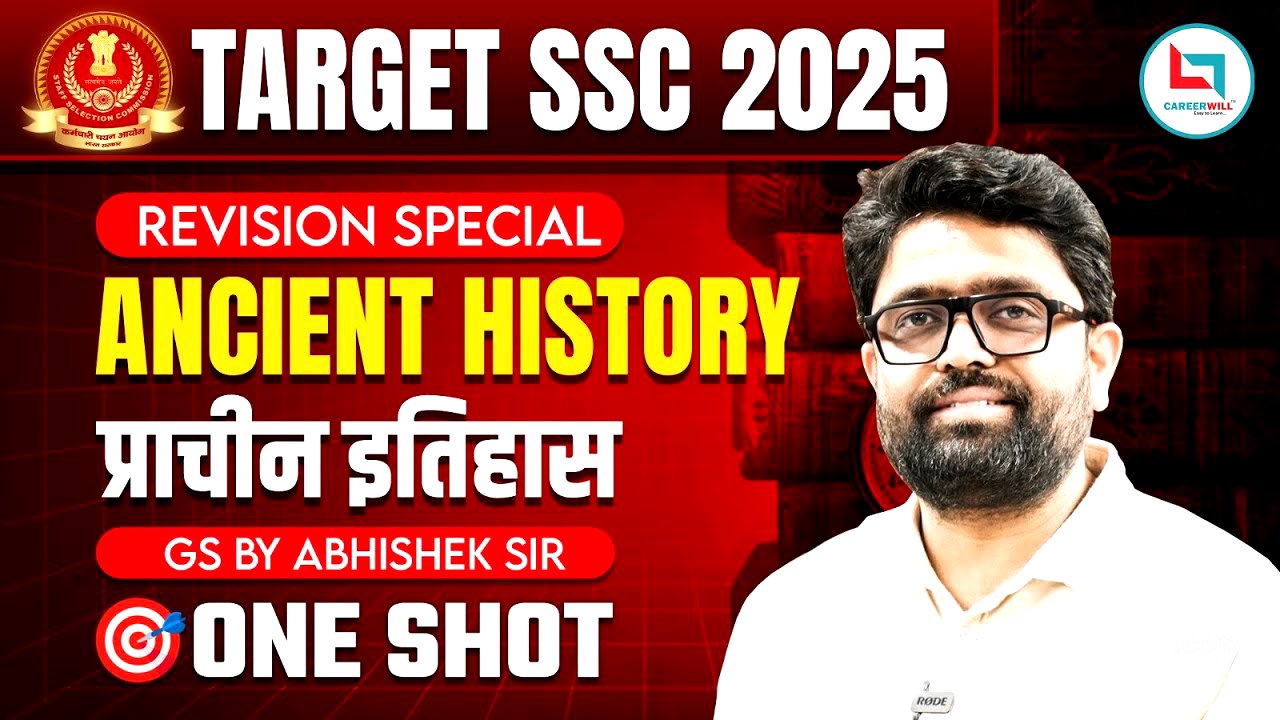TLDR;
This video provides a comprehensive revision of Ancient Indian History, covering topics from the prehistoric period to pre-medieval India. It discusses the sources of history, the divisions of Indian history, and key periods such as the Stone Age, Chalcolithic Age, and Iron Age. The video also covers the Indus Valley Civilization, the Vedic period, the rise of Magadha, and various dynasties, including the Mauryan Empire and post-Mauryan dynasties. Additionally, it touches on the religious movements of Jainism and Buddhism, as well as South Indian dynasties like the Cholas and Pallavas.
- History definition and sources
- Division of Indian history into Ancient, Medieval, and Modern periods
- Stone Age, Chalcolithic Age, and Iron Age
- Indus Valley Civilization
- Vedic period
- Rise of Magadha and Mauryan Empire
- Jainism and Buddhism
- South Indian dynasties
Introduction to Indian History [0:03]
The session will focus on revising Indian ancient history, which is crucial for upcoming SSC exams in 2025. History is defined as a book that provides information about past events with verifiable sources or proof. The term "history" is derived from the Greek word "Historia," meaning information gathered through investigation. Herodotus, known as the Father of History, wrote "Historica," detailing past events. Historical sources are divided into archaeological (inscriptions, monuments, coins, statues, remains, seals) and literary sources (religious texts like Ramayana, Mahabharata, Rigveda; non-religious texts like Chanakya's Arthashastra, Megasthenes' Indica; and accounts from foreign travelers like Hiuen Tsang and Ibn Batuta).
Divisions of Indian History [6:44]
Indian history is divided into three parts: Ancient India, Medieval India, and Modern India. Ancient India is further divided into the Pre-Historic Period, Proto-Historic Period, and Historic Period. The Pre-Historic Period lacks written records, relying on archaeological remains. The Proto-Historic Period has written records that remain undeciphered, such as those from the Indus Valley Civilization. The Historic Period includes written records that have been deciphered.
Pre-Historic Period: Stone Age, Chalcolithic Age, and Metal Age [11:15]
The Pre-Historic Period is divided into the Stone Age, Chalcolithic (Copper) Age, and Metal Age. During the Stone Age, humans used stones for tools due to their nomadic lifestyle of hunting and gathering. The first metal discovered was copper, leading to the Chalcolithic Age, where both stone and copper were used. The Indus Valley Civilization marked the Bronze Age, with bronze made by mixing tin and copper. Around 1000 BCE, iron was discovered in Uttar Pradesh, leading to the Iron Age.
Stone Age: Paleolithic, Mesolithic, and Neolithic Periods [15:41]
The Stone Age is divided into the Paleolithic, Mesolithic, and Neolithic periods. The Paleolithic period, lasting approximately 2 million years, was characterized by hunting and food gathering. Fire was invented, and evidence of ostriches has been found. The Paleolithic period is further divided into Lower, Middle, and Upper Paleolithic. The Lower Paleolithic period (2 million years ago) used quartzite stones for tools, with two main cultures: Chopper Chopping Pebble Culture and Hand Axe Culture. Robert Brucefoot discovered the first hand axe in 1863 AD and is known as the father of Indian Prehistoric Archaeology. The Middle Paleolithic period (80,000 years ago) saw the use of Jasper Flint and Chard stones, with the creation of tools like the Palak. The Upper Paleolithic period (35,000 years ago) saw the evolution of Homo sapiens and the creation of blade tools. Cave paintings and rock shelters have been found in Bhimbetka.
Mesolithic and Neolithic Periods [30:52]
The Mesolithic period (12,000 to 10,000 years ago) saw climate changes, leading to increased vegetation and herbivore populations. Microliths (small-sized tools) were used. The earliest evidence of human skeletons was found in Uttar Pradesh. Domestication of animals began, with evidence found in Rajasthan and Madhya Pradesh. The Neolithic period (10,000 years ago), also known as the New Stone Age, saw the invention of the Celt tool and the start of agriculture. The earliest evidence of agriculture was found in Mehrgarh, with barley, wheat, and cotton cultivation. Rice cultivation began in Uttar Pradesh. Important sites include Catal Huyak in Turkey, and Burj Hom and Gufkral in Jammu and Kashmir.
Megaliths and Chalcolithic Period [39:24]
Megaliths (graves and memorials) began around 3000 years ago, with three types: Kane Circles, Dolmens, and Main Hirs. The Chalcolithic period (5000 years ago) saw the use of both copper and stone for tools. The first use of copper was about 5000 years ago, with a copper hand axe found near Madras. This period is also called the Pre-Harappan Culture.
Metal Age and Indus Valley Civilization [43:17]
The Metal Age includes the Copper Age, Bronze Age, and Iron Age. The Indus Valley Civilization, also known as the Harappan Civilization, existed from 2500 to 1750 BCE. It is considered contemporary to the Mesopotamian Civilization. Discovered in 1921 by Rai Bahadur Dayaram Sahni, it revealed that India's oldest civilization was not the Vedic Civilization but the Harappan Civilization.
Discovery and Extent of Harappan Civilization [46:31]
The discovery of the Harappan Civilization began with railway track laying in the mid-19th century, where baked bricks were found. Alexander Cunningham tried to collect and research the remains. Under Lord Curzon, archaeological excavations started, and John Marshall was made the president of the Archaeological Survey of India. In 1921, Rai Bahadur Dayaram Sahni discovered Harappa, and in 1922, R.D. Banerjee discovered Mohenjo-daro. The civilization extended beyond the Indus Valley, from the Chenab River in the north to the Godavari River in the south, and from the Da River in the west to the Hindon River in the east.
Key Features and Sites of Harappan Civilization [56:58]
The Harappan Civilization is an urban civilization known for its town planning and drainage system. Charles Mason first found evidence in 1826. Alexander Cunningham is called the Father of Indian Archaeology. Key sites include Harappa (Pakistan), known for its 12-chamber granary and Cemetery R37; Mohenjo-daro (Pakistan), known for its Great Granary and Great Bath; Chanudaro, a rural site without a citadel; Dawood Jali Heading (Assam), known for Jadeite Stone; Mehargarh (Balochistan), with evidence from the Neolithic period to Harappan civilization; Rakhigarhi (Haryana), the largest site in India; Lothal (Gujarat), a port town and commercial capital; and Dholavira (Gujarat), divided into three parts: Citadel, Middle Town, and Lower City.
Metals, Town Planning, and Decline of Harappan Civilization [1:06:42]
The Harappan people used copper from Rajasthan, bronze made by mixing tin, and gold from Kolar. Town planning involved dividing cities into two parts: the Western Mound (citadel) and the Eastern Mound (lower city). The ruling class lived in the citadel, while merchants and artisans lived in the lower city. The civilization had an excellent drainage system with baked brick houses and covered drains. Around 1750 AD, the civilization declined due to various reasons, including resource exhaustion, climate change, and river floods.
Vedic Period: Introduction and Aryan Arrival [1:12:14]
After the decline of the Harappan Civilization, the Vedic period began around 1500 BCE with the arrival of the Aryans. The word "Vedic" comes from "Veda," meaning knowledge. The Aryans, meaning "superior," started a rural civilization based on agriculture and animal husbandry. The Vedic period is divided into the Rig Vedic period (1500-1000 BCE) and the Post Vedic period (1000-600 BCE). Max Muller believed the Aryans came from Central Asia. The Aryans occupied the region from Kashmir to northern Rajasthan and from Afghanistan to the western banks of the Ganges, naming it Aryavarta.
Names of India and Vedic Literature [1:18:09]
India has been known by various names, including Bharatvarsh, Hindustan, and India. The Persians called the Sindhu River the Hindu River, leading to the name Hindustan. The Greeks called the river Indus, leading to the name India. The Chinese called the country Yantu, and Ashoka's inscriptions referred to it as Jambu Dwipa. Constitutionally, the country is known as India and Bharat. The Vedic civilization was based on agriculture and animal husbandry, with patriarchal families. Sources of information about the Vedic period are Vedic Literature or Aryan Literature, written in Sanskrit.
Rig Vedic Literature and Vedas [1:21:47]
Vedic Literature is divided into Rig Vedic Literature and Post Vedic Literature. Rig Vedic Literature includes the four Vedas: Rigveda, Samaveda, Yajurveda, and Atharvaveda. The Vedas are believed to have originated from God. Simplified versions of the Vedas are called Brahmanas, Aranyakas, and Upanishads. There are 108 Upanishads, with 12 being certified.
Post Vedic Literature and Vedangas [1:24:13]
Post Vedic Literature is memorized and includes the Vedangas (six in number): Education, Kalpa, Grammar, Nirukta, Verse, and Astrology. Each Veda has an Upveda: Ayurveda, Shilpa Veda, Gandharva Veda, and Dhanurveda. Kalpasutras are also included, which are Srautasutra, Graha Sutra, and Dharma Sutra.
Rigveda and Samaveda [1:26:48]
The Rigveda is the oldest Veda, with 10 mandalas (divisions) and 1028 hymns. Mandalas 2-7 are the oldest, while the 10th is the newest. The Rigveda has two Brahmanical texts: Etri Brahmana and Kaushitaki Brahmana. Its Upveda is Ayurveda. Saraswati is described as the holiest river in the Rigveda. The third Mandal contains the Gayatri Mantra, dedicated to Savitri. The Samaveda, derived from "Saman" (singing), contains mantras from the Rigveda that are sung. It is known as the Father of Indian Music and mentions the seven notes of music.
Yajurveda and Atharvaveda [1:37:32]
The Yajurveda, derived from "Yaju" (worship), contains rules and religious rituals of Yajnas. It is the only Veda written in prose and is divided into Krishna Yajurveda and Shukla Yajurveda. Its Brahmana texts are Taittireeya Brahmana and Shatapatha Brahmana, and its Upveda is Dhanurveda. The Atharvaveda, the newest Veda, contains 20 chapters and 6000 mantras. It includes mantras related to witchcraft, hypnotism, and relief from spirits. Its Brahmana is Gopath Brahmana, and its Upveda is Shilpa Veda.
Aryanakas and Upanishads [1:40:55]
Aryanakas are Brahmin texts composed in forests, with seven currently available. Upanishads are ancient Indian philosophical thoughts and are called the Father of Indian Philosophy. The word "Upanishad" means sitting close by, referring to disciples learning near their Guru. There are 108 Upanishads, with 12 authenticated. The Mundakopanishad contains the national phrase "Satyameva Jayate."
Ashram System and Vedanga Sutra [1:44:10]
The Jabalu Upanishad describes the four stages of human life: Brahmacharya (celibacy), Grihastha (worldly life), Vanaprastha (meditation), and Sanyasa (renunciation). The Vedanga Sutra supports the knowledge of the Vedas and includes acoustics, religious ethics, grammar, etymology, measurement theory, and astronomy.
Later Vedic Period and Puranas [1:46:45]
The Ramayana, composed by Maharishi Valmiki, and the Mahabharata, composed by Krishna Dwaipayana Vedavyasa, were written in the later Vedic period. The Vishnu Purana describes ten incarnations of Vishnu: Matsya, Varaha, Kachhapa, Narasimha, Vamana, Parashurama, Shri Ram, Shri Krishna, Lord Buddha, and Kalki.
Emergence of Mahajanapadas [1:48:35]
Around 600 BCE, small communities became districts, and Janapadas became Mahajanapadas. The use of iron tools increased agricultural productivity, leading to urbanization. Sixteen Mahajanapadas emerged, with Magadha becoming the most powerful. Information about these Mahajanapadas comes from Buddhist texts (Anguttara Nikaya) and Jain texts (Bhagwati Sutra).
Sixteen Mahajanapadas and Religious Movements [1:51:47]
The sixteen Mahajanapadas included Anga, Magadha, Kashi, Kaushal, Vatsa, Chedi, Kuru, Panchal, Matsya, Shursen, Ashmak, Avanti, Gandhara, Kamboja, Waji, and Mal. Ashmak was the only Mahajanapada in Dakshinapath (South India). The caste system, based on birth, led to religious movements, with the emergence of Jainism and Buddhism.
Jainism: Tirthankaras and Principles [1:58:52]
Jainism believes in 24 Tirthankaras, with Rishabhdev considered the first. Parshvanath, the 23rd Tirthankara, gave four Mahavratas: Truth, Non-violence, Non-stealing, and Non-possessiveness. Mahavir Swami, the 24th Tirthankara, is considered the real founder of Jainism. He added celibacy to the five Mahavratas. Jainism also emphasizes three jewels: Proper knowledge, Right view, and Right character.
Jain Councils and Sects [2:06:44]
The first Jain Mahasangiti was organized in 300 BC in Pataliputra, where Jainism was divided into two sects: Svetambara (white-clad) and Digambara (sky-clad). The second Jain Mahasangiti was organized in 512 AD in Vallabhi, Gujarat, where Jain teachings were scripted for the first time and called Agama.
Buddhism: Gautam Buddha and His Teachings [2:10:35]
Buddhism was founded by Gautam Buddha, known as the Light of Asia. Born in Lumbini in 563 BCE, his childhood name was Siddhartha. After witnessing suffering, he left home at age 29, an event called Mahabhinishkramana. He attained enlightenment in Gaya at age 35 and gave his first sermon in Sarnath, stating the four noble truths and the Eightfold Path.
Buddhist Councils and Sects [2:20:29]
The first Buddhist Mahasangiti was organized in 483 BC in Rajgriha, where the Suttapitaka and Vinaypitaka were added. The second Buddhist council was held in 383 AD, where Buddhism divided into Sthapavir and Mahasanghika. The third Buddhist Mahasangiti was organized around 250 BCE in Pataliputra, where the Abhidhamma Pitaka was added. The fourth Buddhist Mahasangiti was organized in 78 AD, where Buddhism divided into Hinayana and Mahayana.
Buddhist Monuments and Rise of Magadha [2:23:21]
Buddhist places of worship are called Chaityas, residences of monks are called Viharas, and sacred buildings on the remains of monks are called Stupas. The Rise of Magadha began around 600 BC, with the Haryanka Dynasty, Shishunaga Dynasty, and Nanda Dynasty.
Haryanka Dynasty and Shishunaga Dynasty [2:25:47]
The Haryanka Dynasty was founded by Bimbisara, with Rajgriha as its capital. Bimbisara's royal physician was Jivak. Ajatashatru, Bimbisara's son, killed him and organized the first Buddhist Council. Udayana, Ajatashatru's son, established Pataliputra as the capital. The Shishunaga Dynasty was founded by Shishunaga, who ended the Avanti dynasty and shifted the capital to Vaishali.
Nanda Dynasty and Foreign Invasions [2:32:07]
The Nanda Dynasty was founded by Mahapadmand, who conquered Kalinga. Dhanananda was the last king of the Nanda dynasty. During his reign, Alexander invaded India in 326 BC. The first foreign invasion was the Persian invasion around 519 BCE, with Darius I as the first invader. The Greek invasion was led by Alexander, who fought Porus in the Battle of High Deedspies.
Mauryan Empire: Chandragupta Maurya [2:39:53]
Chandragupta Maurya, with the help of Chanakya, overthrew Dhanananda and founded the Mauryan Empire. He is identified as Sandrokottos by William Jones. Plutarch and Justin stated that Chandragupta Maurya had an army of 640,000 soldiers. He constructed Sudarshan Lake in Gujarat. In 305 BCE, Seleucus Nicator invaded, but a treaty was signed, and Chandragupta Maurya gifted 500 elephants.
Bindusara and Ashoka [2:45:38]
After Chandragupta Maurya, Bindusara became the next king. He was called Amitrochaetes by the Greeks and followed the Ajivika sect. Two foreign ambassadors, Dimekus and Dionysius, came to his court. After Bindusara's death, Ashoka became the ruler after killing his 99 brothers. He fought the Kalinga war in 261 BC, which led him to adopt Buddhism.
Ashoka's Inscriptions and Post-Mauryan Period [2:49:13]
Ashoka's inscriptions are the oldest in India, written in Brahmi and Kharosthi scripts. James Prinsep first read them in 1837. Ashoka's inscriptions are divided into rock edicts, pillar articles, and cave impressions. After Ashoka, the Mauryan Dynasty declined, and Brihadratha was the last king. Pushyamitra Shunga, a Brahmin general, killed Brihadratha and founded the Shunga Dynasty.
Shunga Dynasty and Kanva Dynasty [2:55:50]
The Shunga Dynasty was founded by Pushyamitra Shunga, who performed two Ashvamedha Yagyas. Agnimitra Shunga was his successor, about whom information is available in Kalidasa's play Malavika Agnimitram. The Kanva Dynasty was founded by Vasudeva after killing Devabhuti, the last king of the Shunga dynasty.
Andhra Satavahana Dynasty and Foreign Invasions [2:58:10]
The Andhra Satavahana Dynasty was founded by Simuk after killing Susharma, the last king of the Kanva dynasty. Gautamiputra Satakarni was its greatest king. The Satavahanas were the first to issue coins with rulers' images, donate land to Brahmins, and use their mother's names before their own. The post-Mauryan period saw foreign invasions, including the Indo-Greeks, Scythians, Parthians, and Kushans.
Indo-Greeks and Scythians [3:00:46]
The Indo-Greeks, originating from Bacteria, were the first to issue gold coins in India. Menander, their greatest king, adopted Buddhism. The Scythians, originating from Central Asia, had five branches. Rudradaman was one of their greatest rulers.
Parthians and Kushans [3:03:54]
The Parthians, also known as Pallavas, came from Persia. Gondophernes was their greatest king. The Kushan Dynasty, originating from Western China, was founded by Kujulagarh Fishes. Kanishka, their greatest ruler, started the Shaka Samvat calendar and organized the fourth Buddhist Council, where Buddhism divided into Hinayana and Mahayana.
Gupta Empire: Golden Era of India [3:06:59]
The Gupta Empire, considered the First Golden Era of Indian History, was founded by Shrigupta. Chandragupta I was the actual founder, marrying a Lichchhavi princess, Kumar Devi. Samudragupta, their son, is called the Napoleon of India.
Samudragupta and Chandragupta II [3:08:49]
Samudragupta, known as the Napoleon of India, adopted policies to expand the empire. Harisena wrote Prayag Prashasti praising him. Chandragupta II, after killing his elder brother Ramgupta, became the next ruler.
Chandragupta II and Kumaragupta [3:12:11]
Chandragupta II was the first Gupta ruler to issue silver coins and brought the Navratnas (nine gems) to his court. The Chinese traveler Fa Hien visited India during his reign. Kumaragupta, Chandragupta II's son, founded Nalanda University.
Skandagupta and Post-Gupta Period [3:13:56]
Skandagupta, considered the last great ruler of the Gupta dynasty, faced Hun invasions. The last ruler of the Gupta Dynasty was Vishnugupta. After the Gupta Empire, the Pushyabhuti Dynasty or Vardhan Dynasty emerged, with Harshvardhan as its greatest king, known as the last Hindu emperor of India.
Harshvardhan and South Indian Dynasties [3:16:22]
Harshvardhan's court poet was Banbhatta, who wrote Harshacharita and Kadambari. The Chinese traveler Hiuen Tsang visited India during his reign. In South India, the Sangam period saw the composition of Tamil poems. The three Sangams were held under the Pandyas of Madurai.
South Indian Dynasties: Chera, Chola, Chalukya, and Pallava [3:18:29]
Dynasties in the Sangam Period included the Chera kingdom, the Chola kingdom, and the Pandya kingdom. The Chalukya Dynasty was founded by Pulakeshin I, with Pulakeshin II as its greatest king. The Pallava Dynasty was founded by the lions of Vishnu, with Narasimha Varman I as its greatest king.
Great Chola Empire and Tripartite Struggle [3:21:12]
The Great Chola Empire was founded by Vijayalaya. Rajaraja I and Rajendra I were its most prominent rulers. After Harshvardhan's death, Kannauj became the main political center, leading to a tripartite struggle between the Gurjar Pratihara Dynasty, Rashtrakutas of Deccan, and Palas of Bengal.
Rajput Era and Dynasties [3:23:34]
The Pratiharas won the tripartite struggle, and Nagabhatta II ruled Kannauj. The Rajput Era began, with dynasties including the Gurjar Pratihara Dynasty, Garhwal Dynasty, Chauhan Dynasty, Chandela Dynasty, Parmar Dynasty, Chalukya Dynasty, and Pala Dynasty.
Garhwal Dynasty and Chauhan Dynasty [3:23:57]
The Garhwal Dynasty of Kannauj was founded by Chandradev. King Jaichandra helped Mohammad Ghori in the Second Battle of Tarain. The Chauhan Dynasty was founded by Vasudev, with Prithviraja III (Prithviraj Chauhan) as its famous ruler.
Chandela Dynasty and Parmar Dynasty [3:25:49]
The Chandela Dynasty of Bundelkhand was founded by Nunuk. Yashovarman founded the Khajuraho Vishnu Temple. The Parmar Dynasty of Malwa was founded by Sayak or Shri Harsha, with Bhoj as its greatest king.
Chalukya Dynasty and Pala Dynasty [3:26:32]
The Chalukya Dynasty, also known as the Solanki Dynasty, was founded by Mulraj I. Bhima I was its greatest king. Mularaja II defeated Mohammad Ghori in 1178. The Pala Dynasty of Bengal was founded by Gopal, with Dharmapala establishing Vikramshila University.
Sen Dynasty and End of Ancient India [3:27:33]
The Sen Dynasty of Bengal was founded by Samant Sen. Laxman Sen was its last king. In 12034 AD, Bakhtiar Khilji invaded Bengal, ending the Sen Dynasty and establishing Muslim rule. The session ends with the revision of Ancient India, transitioning into Medieval India.









